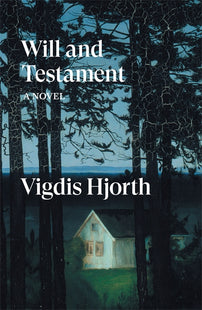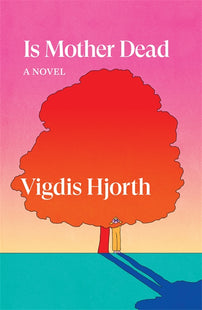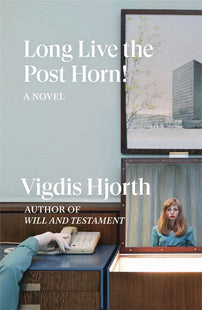How It Should Be Between People
The novels of Vigdis Hjorth, one of Norway’s most celebrated writers, offer a powerful meditation on what it means to relate to other people.

About halfway through Vigdis Hjorth’s A House in Norway, her protagonist, Alma, a textile artist and reluctant landlord, declines her boyfriend’s invitation to join him on a trip with several other couples at a cabin in the woods. The boyfriend, disappointed, lectures Alma ‘about normality’, a recurring theme in their relationship:
She paid close attention as he stated his case in order to use his ideas for her tapestry about relationships between people […]. That she didn’t argue back as usual but listened attentively, he viewed as encouragement and so he held forth at length. Other people like being with other people, he said. Other people are interested in other people. Other people are curious about other people. At this point Alma wanted to interject that she was interested in other people, but not in the trivial aspects of their lives, which tended to form the main topic of conversation at dinner parties, but she refrained. He enquired earnestly about Alma’s distrust of other people, had it always been as bad as it was now or had it grown worse over the years. And Alma thought that she would embroider a tapestry of couples at a dinner party just as unbearable and claustrophobic as she experienced them.
The passage is both highly entertaining – Hjorth is frequently hilarious – and richly ironic. Lecturing Alma, her boyfriend overlooks the fact that she too is an ‘other person’ towards whom he might direct his interest. Instead, he treats her distrust as if it were a species of illness. Later, Hjorth reveals that Alma intends her imagined tapestry to be titled ‘How it should be between people’. If Alma envisions an artwork that could truly demonstrate how relationships ‘should be’ between people, the interaction that Hjorth stages – calculated dissimulation on one side, lack of recognition on the other – is the opposite. But if, as seems more likely, the title is tongue-in-cheek, then the relational miscarriage that Hjorth unfolds in this passage cannily undercuts such an artistic ideal. This is definitely not how it should be between people.
Hjorth, who was born in 1959 and lives in Oslo, is one of Norway’s most celebrated contemporary writers. This past spring, her novel Is Mother Dead was longlisted for the International Booker Prize. And in 2019, her best-known and controversial work Will and Testament was longlisted for the National Book Award for Translated Literature. The more one reads Hjorth, the clearer it becomes that ‘how it should be between people’ is as much a question as a statement. In a recent interview, Hjorth has described her process as ‘a kind of investigation. I investigate a moral or ethical dilemma that troubles me, and I never know in advance what I will find out’. If Alma knows what she is doing, she also doesn’t know, and this uncertainty likewise implicates Hjorth and impels her writing.
How should it be between people? Taken together, all Hjorth’s titles that have been translated by Charlotte Barslund into English – A House in Norway (Norvik Press 2017), Will and Testament 2019), Long Live the Post Horn! (Verso 2020), and Is Mother Dead (Verso 2022) – can be viewed as an extended meditation on what it means to relate to other people: how we do it, how we fail at it, how we try again, what happens when a relation is refused, denied, or when we attempt to repair severed ties. Hjorth’s protagonists may be independent, even detached, questioning the routines of everyday life. But they’re not islands. They go for walks, get coffee, and shop for presents with friends. They text, email, mail letters and postcards, and chat on the phone. They participate in national celebrations, attend social functions, and meet with union representatives. They have protected sex with their partners.
Hjorth’s writing examines the most inexorably structural relationships that we have as humans. In A House in Norway, that relationship is between a landlord and her tenant: a fundamental contractual relationship of capitalist society. In Long Live the Post Horn!, human relationships are uncovered through the composition of the letter and associated postal network. In Will and Testament and Is Mother Dead, Hjorth confronts the nuclear family, exploring relationships between parents and children, and between siblings. To put it schematically – though her writing is anything but – Marx and Freud come together in Hjorth: hers are narratives that deal with commodity and oedipal relations, with relations that we cannot help having.
[book-strip index="1" style="buy"]
But there is also something else: a confrontation with the self, which, for Hjorth, is what allows us to have honest relationships with other people – landlords, tenants, parents, children, friends, lovers, siblings. Alma feels the need to make her tapestry because she rejects her boyfriend’s acceptance of the norms of middle-class Norwegian society even as she knows herself to be a part of this world. Hjorth’s unusual move, narrating A House in Norway from the perspective of the landlord, rather than that of her tenant Slawomira Trzebuchwskai (a Polish immigrant and single mother, whose husband is jailed for domestic abuse), enables her to expose the ethical contortions into which the left-leaning Alma is increasingly knotted. During the cold winter months, Alma is aggravated by Slawomira’s profligate use of electricity– a preoccupation that tips ominously into obsession after Alma decides she has no choice but to increase the rent in order to pay her own bills. It is through these kinds of uncomfortable negotiations that Alma’s commitment to the project of ‘How it should be between people’ is revealed to be part of a larger struggle to come ‘face to face with herself’.
The necessity of facing oneself as the precondition of having meaningful relationships with other people is broached repeatedly in Hjorth’s books. In Is Mother Dead, the narrator can forgive her mother for her inconsistent parenting, but not for her ‘stock phrases’ – for internalizing conventions ‘like a map’, as a way of avoiding the discomfort of self-recognition. In A House in Norway, the challenge of facing oneself is crystallized by a trip to Trieste that Alma takes in order to work on her ‘Constitution’ tapestry, a lucrative project commissioned in honor of the centenary of women’s suffrage and the Norwegian Constitution Bicentenary. In the city streets, Alma encounters a small protest and becomes transfixed by the bystanders: ‘What kind of people were they? Why weren’t they protesting?’ She embroiders them ‘in dark threads’, depicting their arms as ‘helpless, useless, long and paralysed along their bodies’. It is only when she returns to Norway that she is able to acknowledge the ‘embarrassing and unflattering truth’: she recognizes herself in ‘the impotent spectators on the pavement’, and this identification is the source of her fascination. If Hjorth’s protagonists are judgmental, they are often hardest on themselves.
What restores Hjorth’s characters is their deep connection with the non-human environment. A more authentic ‘perception of the ordinary’, and by extension of the self, is developed by foraging for mushrooms, attending to cloudberries, alder bushes, a brook with light foam, a big spruce forest, grasses that ‘lie down to sleep when night falls’. Reorienting oneself towards the natural world becomes a way to manage, if not dissolve, fears, anxieties, and griefs. Hjorth’s writing about nature has been little discussed by critics, but it engenders some of her most lyrical prose. Consider the following passage from Is Mother Dead:
I greet the wet stone and the tallest pine tree that reaches up to the blue gash in the sky, the wind chatters and pine cones fall, rotten branches snap under my feet and crows gather and caw, I walk down my own path, then follow another, a narrow ribbon with the strangest bends, I walk further and enjoy it….
Hjorth’s characterization of nature is unsentimental – ‘blue gash’, ‘wind’ that ‘chatters’, ‘rotten branches’ – and her narrator derives real satisfaction from this harshness: ‘I walk further and enjoy it’. The earth may be cold and dark, but it’s never ominous: ‘and I thought I could feel how the sap rose slowly in the trees and in everything else that grew, heather and brushwood and a belated bluebell in between the blades of grass, they were preparing for the frost. And it felt as if life also stirred, sleepy and silent, inside my body, as if my grief settled in me and fell asleep’. Nature is not consolatory, in the sense of enabling the narrator to displace or exorcise her pain, but it does allow her to recognize grief as part of herself, to settle it. I should add that Hjorth’s readers need these moments as much as her narrator. They make the novel’s compelling, but also extremely demanding, style of narration – the recursive sequencing of obsessive thought patterns – possible to bear.
[book-strip index="2" style="buy"]
Alma’s vision for ‘How it should be between people’ also raises the question of how it should be between Hjorth and us, her readers. Johanna, the first person narrator of Is Mother Dead, is an artist, like Alma, though her medium is painting rather than textiles. ‘The relationship of a work of art to reality is uninteresting’, Johanna insists, but ‘the work’s relationship to the truth is crucial; the true value of the work doesn’t lie in its relationship to a so-called reality, but in its effect on the observer’.
Hjorth’s emphasis on ‘truth’, or its Norwegian equivalent, is central to Is Mother Dead and Will and Testament, both of which draw on the discourse of psychoanalysis to examine how relationships are eroded when someone’s truth is suppressed, cancelled, and covered over. But the therapeutic idea that Johanna articulates – that truth is expressed through an intersubjective or analytic relation – is already present in A House in Norway, in Alma’s struggle to complete the Constitution tapestry, which – spoiler alert! – is only finished when she cuts the middle portion out of it, leaving a thin rectangular border. (The tapestry, I should add, is a success; none of Hjorth’s female protagonists are second-rate when it comes to their work.) Hjorth’s final phrase is critical, then, for making sense of her meaning: the work’s ‘true value’ lies ‘in its effect on the observer’ – an ‘effect’ that cannot be controlled or known by the author in advance. Hjorth’s need is our need, her compulsion is our compulsion, and even if her hurt is not our hurt, she makes us feel.
Reading Hjorth, we respond to protagonists pushing towards self-recognition. Hjorth’s narrators don’t ask us to like them. But what they do show us is that there is a horror in not being seen and heard.
In Long Live the Post Horn!, the opposite of this horror – the joy of unexpected connection – is revealed when the disaffected first-person narrator Ellinor, a PR consultant, attends a meeting with representatives from the Norwegian Post and Communication Union, Postkom. Ellinor has been enlisted to help Postkom fight the European Union’s third postal directive, which, if passed, would force its members to compete with EU salary rates and pension costs. At the meeting, Rudolf Karena Hansen, ‘a postman in the county of Finnmark, beyond the Artic Circle’, introduces himself and gives an impromptu speech that exquisitely derails the media education project Ellinor and her colleague Rolf have been tasked with. Describing his job as an embodiment of ‘the struggle between two different Weltanschauungs, or in other words and to put it bluntly, between the interests of the people and those of capitalism’, Hansen frames the postal service in positively miraculous terms: as capable of turning ‘dead letters’ into ‘living ones’. Speaking to a rapt audience, he describes his successful effort to track down one Helga Brun, whose name had been written on a letter that listed no street or post code, just the town of Alta. His work as a postman, he insists, has allowed him to gain ‘a better understanding of how people live together and how they depend on one another’. ‘People are the decisive factor’, he concludes, ‘and that is why post workers must have job security, decent working conditions and enough time to dedicate themselves to this demanding and honourable job’. It’s difficult to communicate the power of this speech in summary (this is where the plug comes: if you’re unsure where to begin with Hjorth, read Long Live the Post Horn!), but Hjorth unfolds it in such a way that we, too, are in the room, animated by a fervent desire to applaud Rudolf Karena Hansen along with the Postkom representatives who give him a standing ovation.
For a writer who dwells so unambiguously with emotional pain and hurt, and who gives us anxious and obsessive narrators prone to making bad decisions and then regretting them (like throwing a snowball at your estranged mother’s window so it accidentally breaks or blasting white noise out of a radio placed by the wall that borders your tenant’s bedroom), there is an extraordinary amount of tenderness in Hjorth. Her protagonists are what the philosopher Adriana Cavarero would describe as ‘inclined’ and therefore open to love – which is always ‘an attack against the self’s balance’ and can become ‘a big mess for everyone’. They make themselves vulnerable, and their actions remind us that language itself is a crucial form that vulnerability must take, if love is to flourish.
One of the most unassumingly tender moments in Is Mother Dead comes when Johanna texts her son ‘don’t be afraid to talk about difficult things’ and gets a crooked face emoji from him in reply. This text is laughably inadequate, and she knows it. It’s unlikely that her imperative construction will do much to encourage communication about what is ‘difficult’. Regardless of their age, children tend to respond in contrary ways to direction from their parents. Yet the implication is that the emoji is still something. What’s interesting is that Johanna’s son seems to recognize that his mother’s direct language masks something that is opaque, difficult to grasp. Why has she texted him? This is an ambiguous situation in which we, as readers, have to fill in the gaps, just like the narrator working to decipher her son’s emoji and just like the son attempting to read between the lines of his mother’s text. What we do feel with some certainty, though, is that this son loves his mother. The point is that he responds, giving her an image of himself trying to think with her, or trying to approach her thought.
Anna Moser is a lecturer in English at the University of Sussex. Her article ‘Feminist Styles of Immanent Critique’ was recently published in Diacritics.
[book-strip index="3" style="buy"]


